As our loved ones age, ensuring their safety becomes a top priority. In this context, non-wearable fall detection systems have emerged as a critical tool. These systems offer a unique advantage, providing safety without the need for wearable devices. This is especially beneficial for seniors who may find wearable devices uncomfortable or intrusive. In this article, we will explore the various aspects of non-wearable fall detection systems and why they are becoming essential for senior care.

What are Non-wearable Fall Detection Systems?
Non-wearable fall detection systems are technologies designed to detect falls without the need for the individual to wear any device. These systems use various technologies such as motion sensors, cameras, and radar to monitor movements and identify falls. This innovative approach ensures that seniors can have their freedom and comfort without compromising on safety.
How Do They Work?
The primary function of these systems is to monitor the environment and detect unusual movements that may indicate a fall. When a fall is detected, the system sends an alert to caregivers or emergency services. This rapid response can be crucial in preventing further injury and ensuring timely medical attention.
Types of Technologies Used
- Motion Sensors: These sensors detect movement and can differentiate between normal activities and falls.
- Cameras: Video surveillance can be used to monitor movements and detect falls.
- Radar: Some systems use radar technology to detect falls through walls and other obstacles.
Benefits of Non-wearable Fall Detection Systems
There are several benefits to using non-wearable fall detection systems. These include:
- Comfort: Seniors do not need to wear any devices, which can be uncomfortable or restrictive.
- Accuracy: These systems can provide accurate fall detection, reducing false alarms.
- Peace of Mind: Families can rest easy knowing their loved ones are being monitored for safety.
Challenges and Considerations
While these systems offer numerous benefits, there are also challenges to consider. These include:
- Cost: High-quality systems can be expensive, which may be a barrier for some families.
- Privacy: Using cameras may raise concerns about privacy and the potential for misuse.
- Installation: Setting up these systems can be complex and may require professional assistance.
Comparison with Wearable Fall Detection Devices
Wearable devices have been a popular choice for fall detection. However, they come with their own set of challenges, such as the need for regular charging and the possibility of being forgotten by the user. In contrast, non-wearable fall detection systems offer a more seamless and unobtrusive solution.
Why Choose Non-Wearable?
For seniors who may be resistant to wearing devices, non-wearable systems provide an ideal alternative. Additionally, they offer continuous monitoring without the need for user intervention.
Implementing Non-wearable Fall Detection Systems
Installing a non-wearable fall detection system requires careful planning to ensure optimal coverage and effectiveness. It’s essential to assess the layout of the home and identify high-risk areas where falls are more likely to occur.
Professional Installation
In many cases, professional installation is recommended to ensure the system is set up correctly and operates effectively. This can also help address any technical issues that may arise during setup.
Case Studies and Success Stories
Many families have shared positive experiences after implementing non-wearable fall detection systems in their homes. These stories highlight the effectiveness of these systems in preventing injuries and providing peace of mind.
Future of Fall Detection Technology
The field of fall detection is constantly evolving, with new technologies and innovations being developed regularly. The future promises even more advanced systems with improved accuracy and additional features to enhance senior safety.
Conclusion
In conclusion, non-wearable fall detection systems offer a valuable solution for ensuring the safety and well-being of seniors. By providing accurate fall detection without the need for wearable devices, these systems offer comfort, peace of mind, and timely intervention when needed. As technology continues to advance, we can expect these systems to become even more integral to senior care.

FAQ Section
What are the main advantages of non-wearable systems?
The main advantages include comfort, accuracy, and peace of mind for both seniors and their families.
Are these systems expensive?
While high-quality systems can be costly, the benefits often outweigh the expenses, especially when considering the safety of loved ones.
How do I choose the right system?
Consider factors such as the layout of the home, the specific needs of the senior, and consult with professionals to find the best system for your situation.
To learn more about how technology is aiding seniors, visit this article from Academic Journals. Additionally, explore comfortable smartwatch options tailored for seniors.
This article contains affiliate links. We may earn a commission at no extra cost to you.

